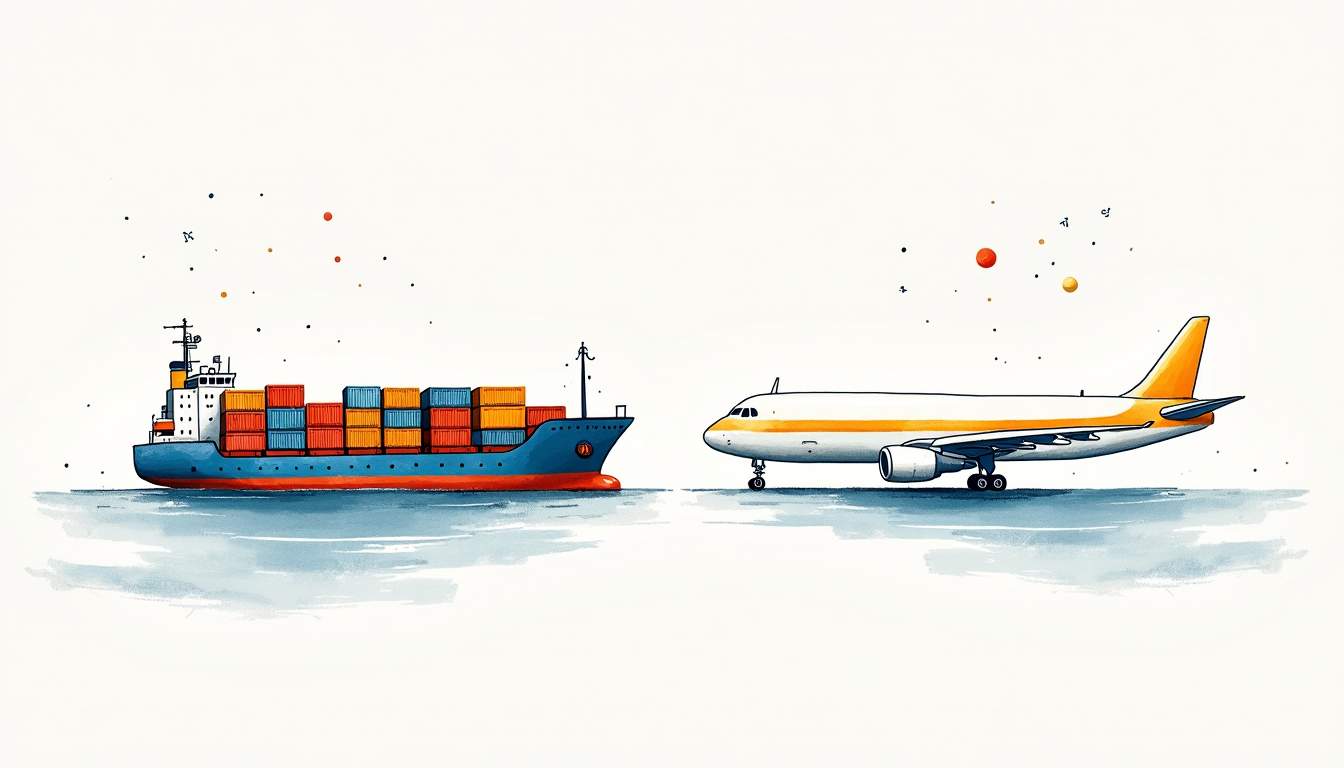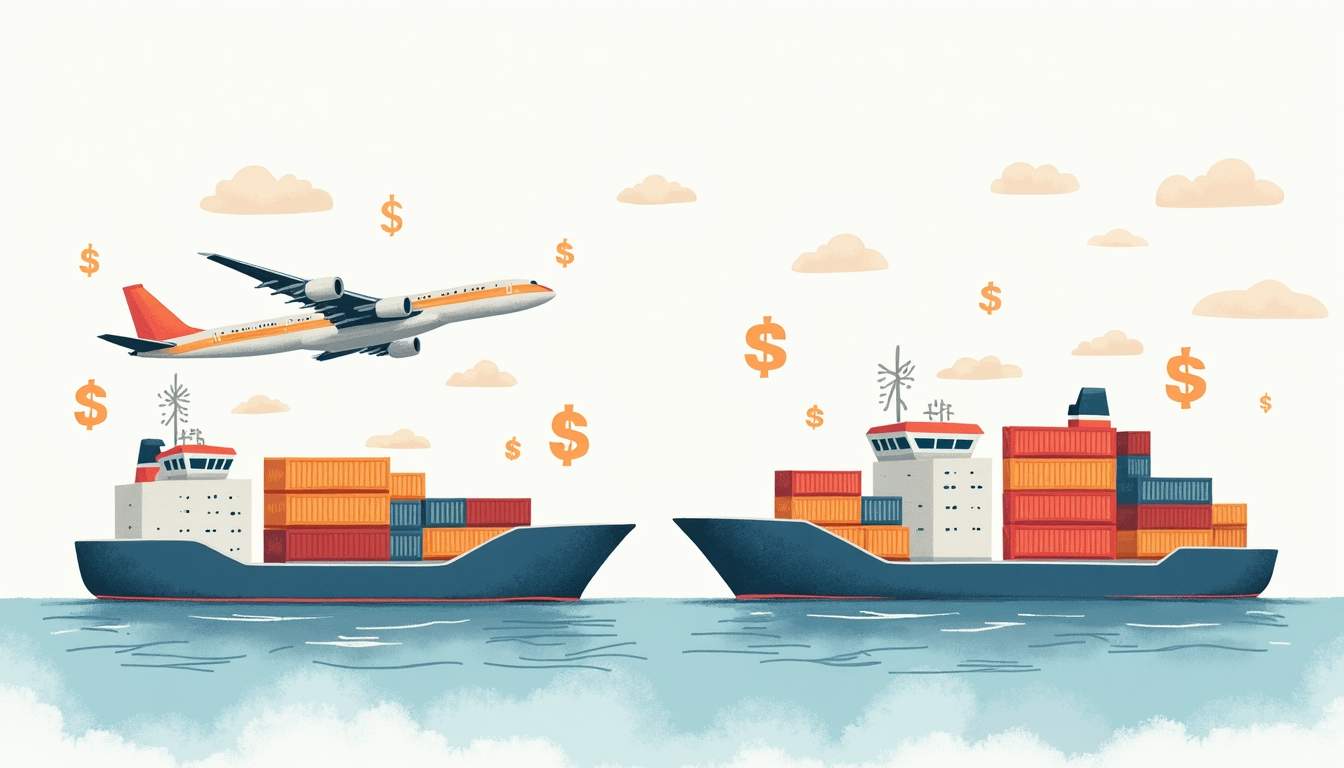Air freight and ocean freight are two of the most common methods for transporting goods across the globe. Each has its unique advantages and disadvantages, making them suitable for different types of shipments. Understanding these differences is crucial for businesses looking to optimize their logistics and supply chain operations. This article delves into the key aspects of air freight and ocean freight, helping you make informed decisions based on your shipping needs.
Sea Freight vs. Air Freight: An Overview
When it comes to international shipping, air freight and ocean freight represent two distinct approaches. Air freight involves transporting goods via aircraft, while ocean freight relies on cargo ships. The choice between these methods often hinges on factors such as speed, cost, and the nature of the goods being shipped.

Air freight is typically preferred for urgent deliveries, where time is of the essence. Conversely, ocean freight is often the go-to option for larger shipments that do not require immediate delivery. Understanding the nuances of each method can help businesses tailor their logistics strategies to meet specific needs.
In addition to speed and cost, the nature of the goods being shipped plays a crucial role in determining the most appropriate shipping method. For instance, perishable items, such as fresh produce or pharmaceuticals, often necessitate air freight to ensure they reach their destination while still in optimal condition. On the other hand, bulky and non-perishable goods, like machinery or furniture, are usually more economical to ship via ocean freight, despite the longer transit times. Furthermore, businesses must also consider the environmental impact of their shipping choices; air freight tends to have a higher carbon footprint compared to ocean freight, which can be a significant factor for companies looking to enhance their sustainability practices.
Another important aspect to consider is the logistics involved in each shipping method. Air freight typically requires more stringent security measures and documentation, which can add to the complexity of the shipping process. Customs clearance for air freight can be expedited, but the associated costs may be higher due to the need for specialized handling and faster processing. In contrast, ocean freight often involves longer lead times, but it can accommodate larger volumes of cargo, making it a more efficient choice for bulk shipments. Additionally, with the increasing popularity of intermodal shipping solutions, businesses can now combine both air and sea freight to optimize their supply chain, allowing for flexibility and cost savings while still meeting delivery deadlines.
Speed of Delivery
Speed is one of the most significant factors influencing the choice between air and sea freight. Depending on the urgency of the shipment, one method may be more advantageous than the other.
Air Freight: Fastest Delivery Options
Air freight is renowned for its speed. With the ability to cover vast distances in a matter of hours, air transport is ideal for time-sensitive shipments. For instance, goods can be flown from one continent to another within a day, making it perfect for industries such as e-commerce, pharmaceuticals, and perishable goods.
Moreover, air freight services often offer expedited options, allowing businesses to further reduce delivery times. This rapid transit capability can be a game-changer for companies needing to respond quickly to market demands or unexpected changes in consumer behavior.
Sea Freight: Transit Times Explained
In contrast, sea freight operates on a much slower schedule. Transit times can range from several days to weeks, depending on the distance and shipping routes. For example, a shipment from Asia to Europe may take anywhere from 20 to 40 days, depending on the specific ports involved and the shipping line used.
While this may seem like a disadvantage, sea freight is often more suitable for non-urgent shipments. Businesses can plan their inventory and production schedules around these longer transit times, allowing for more efficient supply chain management.
Flexibility in Shipping Methods
Flexibility is another critical consideration when choosing between air and sea freight. Each method offers different levels of adaptability to meet varying shipping needs.
Air Freight: Adjusting to Urgent Needs
Air freight provides a high degree of flexibility, particularly for urgent shipments. Companies can quickly adjust their shipping plans to accommodate last-minute orders or changes in demand. With numerous airports and air cargo services available, businesses can often find a flight that meets their timeline.
This flexibility extends to the types of goods that can be shipped. Air freight can handle a wide variety of products, including electronics, fashion items, and medical supplies, making it a versatile option for many industries.
Sea Freight: Options for Bulk Shipments
On the other hand, sea freight excels in handling bulk shipments. Cargo ships have the capacity to transport large volumes of goods, making them ideal for businesses that deal in commodities or raw materials. This capability allows companies to take advantage of economies of scale, reducing the overall cost per unit.
Additionally, sea freight offers various shipping options, including full container loads (FCL) and less than container loads (LCL). This versatility enables businesses to choose the most appropriate shipping method based on their specific needs and budget.
Shipping Dangerous Goods
When it comes to shipping hazardous materials, both air and sea freight have stringent regulations that must be followed. Understanding these regulations is essential for ensuring compliance and safety during transportation.
Regulations for Air Freight
Air freight is subject to strict regulations regarding the transportation of dangerous goods. The International Air Transport Association (IATA) has established guidelines that categorize hazardous materials and outline the necessary packaging, labeling, and documentation requirements.
These regulations are in place to ensure the safety of passengers and crew, as well as to minimize environmental risks. Companies shipping dangerous goods via air must be well-versed in these regulations to avoid penalties and ensure safe transport.
Regulations for Sea Freight
Similarly, sea freight also has regulations governing the shipment of hazardous materials. The International Maritime Organization (IMO) sets forth guidelines that dictate how dangerous goods should be packaged, labeled, and stowed on ships.
Compliance with these regulations is critical, as failure to adhere to safety standards can lead to severe consequences, including fines and potential harm to the environment. Businesses must ensure they are knowledgeable about the specific requirements for shipping dangerous goods by sea.
Cost Comparison of Shipping Methods
Cost is often a deciding factor when choosing between air and sea freight. Each method has its pricing structure, which can significantly impact the overall logistics budget.

Air Freight: Calculating Volumetric Costs
Air freight costs are generally higher than those of sea freight, primarily due to the speed and convenience it offers. Pricing is often based on the weight or volume of the shipment, with volumetric weight calculations being a crucial aspect of determining costs.
Volumetric weight is calculated by multiplying the dimensions of the package and dividing by a specific factor, which varies by carrier. This means that even lightweight items can incur high shipping costs if they occupy a large volume. Businesses must carefully assess their shipments to understand the cost implications of air freight.
Sea Freight: Understanding Pricing Factors
Sea freight, on the other hand, tends to be more cost-effective, especially for larger shipments. Pricing is influenced by several factors, including the distance between ports, the type of cargo, and the shipping method selected (FCL vs. LCL).
Additionally, businesses should consider other costs associated with sea freight, such as port fees, customs duties, and insurance. While the base rate for sea freight may be lower, these additional costs can add up, making it essential to conduct a thorough cost analysis before making a decision.
Understanding Incoterms
Incoterms, or International Commercial Terms, are essential for defining the responsibilities of buyers and sellers in international shipping. These terms clarify who is responsible for various aspects of the shipping process, including transportation, insurance, and customs clearance.
Understanding Incoterms is crucial for both air and sea freight, as they impact the overall cost and logistics of shipping. For instance, terms like FOB (Free on Board) and CIF (Cost, Insurance, and Freight) dictate how costs are allocated and who bears the risk at different stages of transportation.
Businesses must familiarize themselves with these terms to ensure smooth transactions and avoid misunderstandings that could lead to costly delays or disputes.
Environmental Impact: CO2 Emissions
As sustainability becomes an increasingly important consideration for businesses, the environmental impact of shipping methods cannot be overlooked. Both air and sea freight have distinct carbon footprints that should be evaluated when making shipping decisions.
Air freight is known for its higher CO2 emissions compared to sea freight. The aviation industry contributes significantly to global greenhouse gas emissions, making air transport less environmentally friendly. However, it is essential to consider the urgency of shipments and the potential for reduced emissions through efficient logistics planning.
In contrast, sea freight is generally regarded as a more sustainable option. Cargo ships can carry large quantities of goods with relatively low emissions per unit. However, the environmental impact of shipping can vary based on factors such as the type of fuel used and the efficiency of the vessels.
Businesses are increasingly seeking ways to offset their carbon footprint, whether through investing in greener shipping options, utilizing carbon credits, or adopting more sustainable practices within their supply chains.
Conclusion
In conclusion, both air freight and ocean freight offer distinct advantages and disadvantages. The choice between these methods depends on various factors, including speed, cost, flexibility, and environmental impact. By understanding the nuances of each shipping method, businesses can make informed decisions that align with their operational needs and sustainability goals.
Ultimately, the right shipping method will vary from one shipment to another. Companies must evaluate their specific requirements, including the nature of the goods, urgency, and budget constraints, to determine the most suitable option for their logistics strategy.
Choose Freighter Gator for Your Time-Critical Freight Needs
Deciding between air and ocean freight can be complex, but when time is not on your side, you need a partner you can rely on. Freighter Gator excels in providing fast, flexible air cargo charter solutions tailored to your urgent shipping requirements. With our commitment to punctuality and our ability to handle a diverse range of cargo, we ensure your time-sensitive shipments arrive on schedule. If your business demands the speed and reliability of air freight, request a quote today and experience the peace of mind that comes with choosing Freighter Gator.
